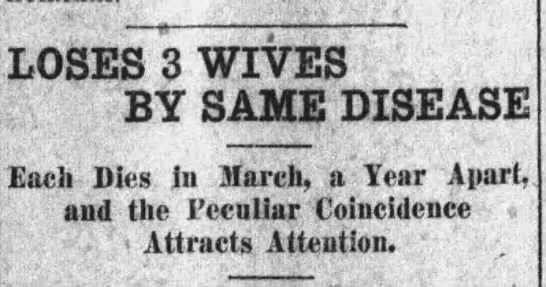 |
| Via Newspapers.com |
When a man becomes a widower three times within three years, one can be pardoned for wondering if something funny was going on. There indeed was, but it was not necessarily what you’d think. The (Owensboro, Kentucky) “Messenger-Inquirer,” April 2, 1907:
Poseyville, Ind, April 1. Zack Watson, of Wadesville, has undergone a peculiar experience. On March 15, two years ago, his wife was seized with convulsions and died in a few hours. He soon remarried and last March, a year almost to a day from the death of the first, Mrs. Watson, the second wife, died of the same disease. Then he married the third time and yesterday his wife died of the same illness and almost in the same manner.
Expert physicians were cabled, but their services were of no avail. Thus it is Mr. Watson has buried three wives in three successive March months. The case is attracting attention because of its striking peculiarity. Mr. Watson is postmaster at Wadesville and is a highly respected citizen.
The sequel appeared in the “Shreveport Times” on April 11:
Evansville, Ind., April 10. It has just developed that the death of Mrs. Zack Watson, living near New Harmony, in Posey county, Ind., was caused by wall paper that contained poison, and not by spinal meningitis, as first thought. Two of the former wives of Mr. Watson died of the same cause. The wall paper in the parlor at Watson's home has been examined and found to contain a virulent poison. When brushed or shaken a fine mica-like substance falls from the paper in a cloud. It was to prevent the mail clerks and postal employees from being poisoned that the government recently forbade the mailing of souvenir postal cards covered with this preparation.Not to doubt this innocent explanation of a triple tragedy, but I for one would decline to be the fourth Mrs. Watson, no matter what was hanging on his walls.
The death of Mr. Watson's wives occurred in March, just about house-cleaning time, and each was taken violently ill shortly after. The last Mrs. Watson was taken ill immediately after having cleaned the parlor.
And the poison becomes even more virulent when you soak a small piece of the wallpaper in a refreshing cup of tea or coffee offered after cleaning the parlor... I was secretly hoping for a colony of poisonous spiders that hatch out in March.
ReplyDeletePoisonous wallpaper was a big thing in victorian england. Arsenic was the best affordable green dye they had. They knew it was poisonous, of course, but they were just, like "So don't lick your wallpaper, it'll be fine."
ReplyDeleteThe actual poison isn't mentioned but it was probably arsenic, which was widely used as a component of the vivid green dyes used in wallpaper and other consumer products. As the paper wore out and began to disintegrate, any disturbance like brushing the walls could release dust particles containing arsenic which would be inhaled by the person doing the cleaning. For more on this subject, search for "Scheele's Green" and the 1874 book "Shadows from the Walls of Death". It has even been suggested that Napoleon might have been poisoned by his green wallpaper while in exile on St Helena. He died of cancer, but the arsenic dyes were also carcinogenic.
ReplyDeletePoor Mr Watson. He must have felt terrible, perhaps thinking that the deaths could have been prevented. Maybe moving to a new house gave added longevity to any fourth Mrs Watson.
ReplyDeleteAnd here I thought this was going to be a lead-in to the old joke about the woman who had lost four husbands; the first three from eating poisonous mushrooms, and the fourth one who died of a fractured skull...
ReplyDelete...because "he wouldn't eat his mushrooms."
-"BB"-